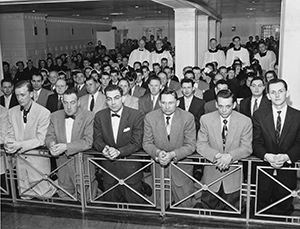 OK, who remembers attending pre-Vatican II Mass in the 1930s, ’40s and ’50s?
OK, who remembers attending pre-Vatican II Mass in the 1930s, ’40s and ’50s?
C’mon, don’t be bashful; raise your hands. I know you’re reading this. There you are – one, two, three … six, 10, 12, 20, 30 and counting.
Wow, there are more of us 60-70 and 80-year-old Latin Mass attendees than I imagined. So, let’s reminisce about church in the ol’ days.
If we attended Catholic grade school, we were trained by Sr. Mary First Grade to Sr. Mary Eighth Grade. And, regardless of religious community, basically they all looked alike – traditional black habit, a knotted white cord dangling waist to toe on one side and super-sized rosary jangling on the other.
With only Sister’s face exposed, I often wondered: Is she blond, brunette or gray haired? Facial expressions ranged from stern to angelic. Nevertheless, we respected and admired them for passing on the faith that we still cherish.
Our parish priests – pastors and assistants – were almost always seen in black cassock and biretta. You remember the biretta – a stiff, square hat with three ridges topped with a fuzzy black ball (reddish if he was a monsignor). Gee, I haven’t seen a cassock or biretta in years.
While in school we attended Mass daily, but received holy Communion only on special occasions … Sundays, holy days and first Fridays, for example.
Confession was a Saturday afternoon ritual. Long lines of penitents kept all priests busy for hours. Before the liturgical changes of the Second Vatican Council, Catholics received the Eucharist by approaching and kneeling at the Communion rail. This photo was taken during Mass at the Paulist Center in Boston in 1955. (CNS photo from The Pilot)
Before the liturgical changes of the Second Vatican Council, Catholics received the Eucharist by approaching and kneeling at the Communion rail. This photo was taken during Mass at the Paulist Center in Boston in 1955. (CNS photo from The Pilot)
Churches were mainly rectangular. Doors opened from the rear beneath a choir loft, rows of pews separated by center and side aisles led to the sanctuary. But, whoa, a Communion railing segregated pews from altar area. Only priests and acolytes entered the sanctuary, so it seemed.
The main altar, anchored against the front wall on an elevated platform, was artistic and ornate with the tabernacle as the focal point. Side altars were dedicated to the Blessed Mother, St. Joseph or parish patron.
Separate sacristies for priests and servers were located on opposite sides of the sanctuary. Prior to Mass, two servers, dressed in white surplice and cassock (black for daily use and funerals, and red for Sundays, feast days and special occasions) crossed over to the priests’ sacristy.
A hand-pulled bell tinkled as servers led the celebrant to the foot of the altar to begin Mass. The priest carried his chalice and paten covered with a vestment-matching colored veil.
Mass prayers were in Latin. The priest faced the altar, occasionally turning to worshippers for a familiar “Dominus vobiscum” (The Lord be with you) to which we so unforgettably responded “Et cum Spiritu tuo” (And with your Spirit). The priest read the Epistle and Gospel in English.
Sr. Mary Acolyte trained those of us boys who were privileged to be servers.
To the priest’s “In nomine Patris, et Filii, et Spiritus Sancti” (In the name of the Father…) we responded “Introibo ad altare Dei” (I will go unto the altar of God.) We memorized the Confiteor “Confiteor Deo omnipotenti” … (I confess to Almighty God…).
We learned when to ring hand bells at the Offertory, Consecration and prior to Communion.
To receive holy Communion we fasted from midnight. Communicants knelt at the railing as the priest placed a host on the tongue, repeating: “Corpus Domini nostri Jesu Christi custodiat animam tuam in vitam aeternam.” Amen. (The Body of Our Lord Jesus Christ preserve thy soul until life everlasting. Amen.) A server followed holding a paten under the communicant’s chin to catch the host if it slipped or dropped. The priest continued back and forth along the rail until all received.
After Communion, the priest re-covered the chalice and paten, offered the closing prayers, returned to the sacristy, returned vestments to a closet and left through a back door. Mass-goers exited almost in silence.
Quite different from attending Mass in 2012! Right? Well, yes and no.
Our Mass, implemented according to Vatican II directives in 1969-70, is the same Mass in revised form, such as:
An open sanctuary with pews arranged somewhat semi-circular, with choir nearby.
The tabernacle in an adjacent eucharistic chapel.
Greeters welcoming worshippers.
An entrance procession with laity carrying crucifix and lectionary.
Boy acolytes … and girls.
Prayers, responses, readings and songs in English.
Lay lectors.
Homilies focusing on the message of Old and New Testament readings and Gospel.
Lay people carrying gifts of bread and wine to the altar.
A sign of peace.
Men and women assisting as extraordinary ministers of the Eucharist.
Receiving the Body of Christ in the hand and Blood of Christ from the cup.
The recessional.
And, the celebrant exchanging pleasantries with departing Mass-goers.
So, with the Latin Mass in the rear view mirror and the Vatican II Mass here, perhaps we should remind ourselves: My, oh, my how times have changed to experience a more inviting, welcoming and friendly church.
(Horn, a retired Catholic Herald reporter, is a member of St. Roman Church, Milwaukee.)
